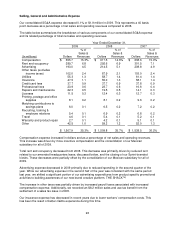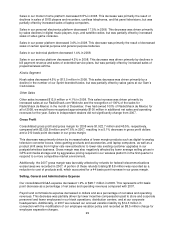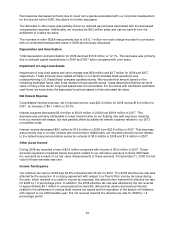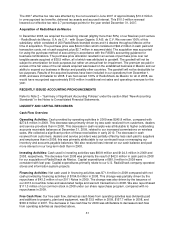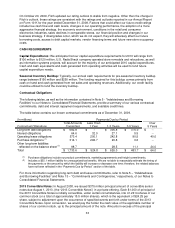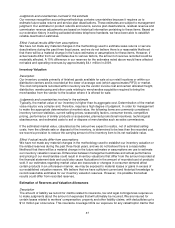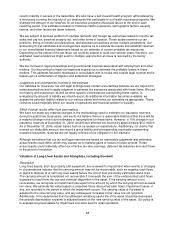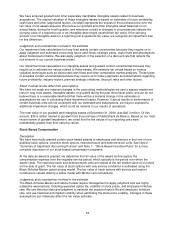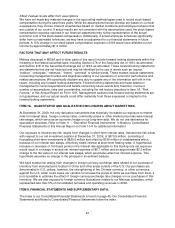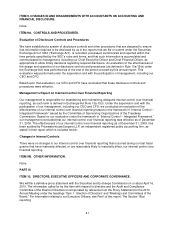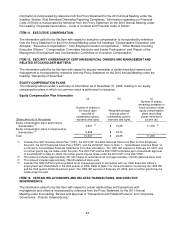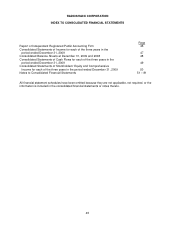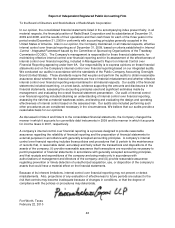Radio Shack 2009 Annual Report Download - page 43
Download and view the complete annual report
Please find page 43 of the 2009 Radio Shack annual report below. You can navigate through the pages in the report by either clicking on the pages listed below, or by using the keyword search tool below to find specific information within the annual report.36
Share Repurchases: In July 2008, our Board of Directors approved a share repurchase program with no
expiration date authorizing management to repurchase up to $200 million of our common stock. In August
2009, our Board of Directors approved a $200 million increase in the dollar amount of this program. As of
December 31, 2009, $290 million of the total authorized amount was available for share repurchases
under this program. No shares were repurchased under this program in 2009.
OFF-BALANCE SHEET ARRANGEMENTS
Other than the operating leases described above, we do not have any off-balance sheet financing
arrangements, transactions, or special purpose entities.
INFLATION
With the exception of increased energy costs in 2007 and the first half of 2008, inflation has not significantly
affected us over the past three years. We do not expect inflation to have a significant effect on our
operations in the foreseeable future.
CRITICAL ACCOUNTING POLICIES AND ESTIMATES
Our consolidated financial statements are prepared in accordance with generally accepted accounting
principles (“GAAP”) in the United States. The application of GAAP requires us to make estimates and
assumptions that affect the reported values of assets and liabilities at the date of the financial statements,
the reported amount of revenues and expenses during the reporting period, and the related disclosures of
contingent assets and liabilities. The use of estimates is pervasive throughout our financial statements
and is affected by management’s judgment and uncertainties. Our estimates, assumptions and judgments
are based on historical experience, current market trends and other factors that we believe to be relevant
and reasonable at the time the consolidated financial statements are prepared. We continually evaluate
the information used to make these estimates as our business and the economic environment change.
Actual results may differ materially from these estimates under different assumptions or conditions.
In the Notes to Consolidated Financial Statements, we describe the significant accounting policies used in
the preparation of our consolidated financial statements. The accounting policies and estimates we
consider most critical are revenue recognition; inventory valuation; estimation of reserves and valuation
allowances specifically related to insurance, tax and legal contingencies; valuation of long-lived assets
and intangibles, including goodwill; and stock-based compensation.
We consider an accounting policy or estimate to be critical if it requires difficult, subjective or complex
judgments, and is material to the portrayal of our financial condition, changes in financial condition or
results of operations. The selection, application and disclosure of our critical accounting policies and
estimates have been reviewed by the Audit and Compliance Committee of our Board of Directors.
Revenue Recognition
Description
Our revenue is derived principally from the sale of name brand and private brand products and services
to consumers. Revenue is recognized, net of an estimate for customer refunds and product returns, when
persuasive evidence of an arrangement exists, delivery has occurred or services have been rendered, the
sales price is fixed or determinable, and collectability is reasonably assured.
Certain products, such as wireless telephone handsets, require the customer to use the services of a
third-party service provider. The third-party service provider pays us an upfront commission for obtaining
a new customer and, in some cases, a monthly recurring residual amount based upon the ongoing
arrangement between the service provider and the customer. Our sale of an activated wireless telephone
handset is the single event required to meet the delivery criterion for both the upfront commission and the
residual revenue. Upfront commission revenue, net of estimated service deactivations, is generally
recognized at the time an activated wireless telephone handset is sold to the customer at the point-of-
sale. Recurring residual income is recognized as earned under the terms of each contract with the service
provider, which is typically as the service provider bills its customer, generally on a monthly basis.


